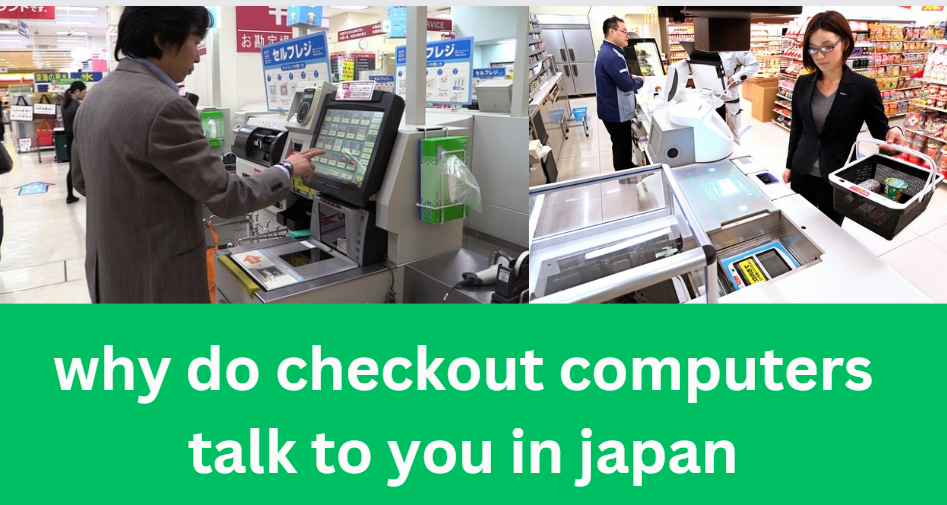In Japan, technology blends seamlessly into everyday life, and one area where this is particularly evident is in retail. From convenience stores to supermarkets, you may have noticed that checkout computers often speak to you as part of the transaction process. But why do checkout computers talk to you in Japan? It may seem like a quirky feature to Western visitors, but this practice is deeply rooted in Japanese culture, inclusivity, customer service, and even technology trends. This article explores the reasons behind this phenomenon, its cultural significance, and how it compares to shopping experiences in other countries, particularly in the United States.
This in-depth look at “why do checkout computers talk to you in Japan” will not only address the question but will provide insights and analysis on a topic that blends technology with cultural sensitivity.
Contents
- 1 1. The Role of Politeness and Customer Service in Japan
- 2 2. Inclusivity and Accessibility: A Key Driver
- 3 3. Efficiency and Error Reduction
- 4 4. Enhancing the Customer Experience
- 5 5. Technological Trends in Japan
- 6 6. How Japan’s Talking Checkout Computers Compare to the U.S.
- 7 7. The Future of Talking Checkout Computers in Japan
- 8 FAQs: Why Do Checkout Computers Talk to You in Japan?
- 9 Conclusion
1. The Role of Politeness and Customer Service in Japan
1.1 Cultural Norms of Politeness
In Japan, politeness and customer service are not just formalities but an ingrained part of society. The Japanese concept of omotenashi refers to the kind of hospitality where service providers go above and beyond to make guests feel welcome. In the context of retail, omotenashi manifests in everything from the way clerks greet customers to the friendly voices of checkout computers. By incorporating polite, automated phrases, such as “Thank you for your purchase” or “Please insert your card,” Japanese stores ensure that even the checkout machines adhere to these cultural norms of respect and kindness.
1.2 The Role of Automated Politeness
The idea of using technology to uphold cultural values is central to the question, “why do checkout computers talk to you in Japan?” When you encounter a speaking checkout machine, it isn’t just a function of technology—it’s a deliberate extension of Japanese politeness. The checkout computers are programmed to say thank you, confirm your actions, and politely guide you through the payment process, which maintains the high standard of service expected by customers in Japan.
2. Inclusivity and Accessibility: A Key Driver
2.1 Ensuring an Inclusive Shopping Experience
Inclusivity plays a vital role in understanding why checkout computers talk to you in Japan. Japan is known for its consideration of others, and this extends to creating a shopping environment that accommodates everyone, including the elderly, visually impaired, and people unfamiliar with technology. Speaking checkout machines are designed to guide users step-by-step through the payment process, ensuring that even those with difficulties reading small print or navigating a touchscreen can complete their transactions independently.
2.2 Audio Guidance for Visually Impaired
One of the core reasons why checkout computers in Japan talk to you is to assist visually impaired customers. The audio guidance feature ensures that people who cannot easily read the screen or see the options clearly are still able to understand what’s happening during the transaction process. In this way, the talking checkout system promotes inclusivity by allowing visually impaired individuals to shop without relying on external assistance.
2.3 Elderly-Friendly Technology
Japan has a rapidly aging population, and technology in public spaces reflects the country’s efforts to cater to older citizens. For older customers, the process of interacting with a digital screen may be daunting. By offering clear, step-by-step audio instructions, checkout computers reduce the confusion that can arise during payment, making the shopping experience smoother and less stressful for older people. The spoken instructions ensure that elderly customers are reassured throughout their transaction, preventing mistakes and helping them feel comfortable using new technology.
3. Efficiency and Error Reduction
3.1 Streamlining the Payment Process
Beyond cultural values, another reason why checkout computers talk to you in Japan is to streamline the payment process. Clear verbal instructions can help guide customers through various steps of the transaction, such as selecting payment methods, scanning loyalty cards, or finalizing the payment. This reduces confusion, especially for tourists or first-time users, and ensures that transactions are completed quickly and efficiently.
3.2 Reducing Errors with Verbal Prompts
Checkout errors can slow down the process and frustrate both customers and staff. When a checkout machine asks you to “please confirm your payment” or “insert your card,” it reduces the chances of users missing a step or making an error. In this way, the talking checkout system serves as a gentle reminder for actions that might otherwise be overlooked, ensuring a smoother, more error-free checkout experience.
3.3 Assisting Non-Japanese Speakers
Japan is a popular tourist destination, attracting millions of visitors every year. For tourists who may not speak or read Japanese fluently, verbal prompts in multiple languages can make the checkout process easier to navigate. Some checkout computers in Japan offer audio prompts in English or other languages, catering to the needs of international shoppers and minimizing the stress of language barriers during payment.
4. Enhancing the Customer Experience
4.1 A Personalized Touch with Technology
Technology in Japan often aims to enhance the overall customer experience, and talking checkout computers are no exception. By speaking directly to customers, these machines provide a more personalized, engaging interaction compared to silent machines. The voice adds a human touch, even in an automated setting, aligning with Japan’s culture of hospitality. The spoken prompts make customers feel acknowledged and appreciated, which contributes to a positive shopping experience.
4.2 Creating a Familiar and Welcoming Environment
Japanese retailers often strive to create a familiar and welcoming environment for their customers. By using polite, friendly language, checkout computers mimic the interactions one would have with a human cashier. This helps to make the automated checkout process feel less mechanical and more comfortable, especially for customers who might otherwise find interacting with machines impersonal.
5. Technological Trends in Japan
5.1 Japan’s Embrace of Automation
Japan is well known for its advancements in robotics and automation. From high-tech vending machines to AI-powered customer service robots, technology plays a significant role in daily life. In retail, this extends to checkout systems, where automation not only increases efficiency but also adds convenience for customers. Talking checkout computers are part of this broader trend of integrating technology into everyday tasks in a user-friendly way.
5.2 Voice-Activated Technology as a Norm
Voice technology is becoming increasingly prevalent in Japan, with many industries incorporating voice-activated systems into their operations. In retail, this means that talking checkout machines are just one example of how voice technology is being used to enhance customer interactions. Whether it’s ordering food at a kiosk or paying at a convenience store, voice prompts are becoming a common way for people to interact with machines, helping bridge the gap between human interaction and automation.
5.3 Leveraging AI for a Seamless Experience
The integration of artificial intelligence (AI) into checkout systems allows for even more customization and personalization. AI can analyze customer behavior and preferences, offering personalized prompts and suggestions during the checkout process. While not all Japanese checkout computers currently use AI, this is a potential direction for the future of talking machines in retail, making the shopping experience even more seamless and tailored to individual needs.
6. How Japan’s Talking Checkout Computers Compare to the U.S.
6.1 Cultural Differences in Retail Technology
The U.S. also uses automated checkout systems, but why do checkout computers talk to you in Japan and not as frequently in the United States? The answer lies in cultural differences. While both countries value efficiency, Japanese culture places a stronger emphasis on politeness and inclusivity, as previously discussed. In the U.S., checkout machines are often designed for speed, with less focus on delivering a polite or guided experience. Additionally, verbal prompts in the U.S. are less common, likely due to concerns about slowing down the transaction process.
6.2 The U.S. Focus on Efficiency Over Interaction
In the United States, self-checkout systems prioritize speed and convenience, with minimal interaction. Most U.S. systems rely on visual cues and text-based instructions, assuming that users will quickly understand the process. While there may be audio prompts, these are typically limited to warnings or errors (e.g., “Please scan your next item” or “Approval needed”). This contrasts with Japan, where verbal interaction is seen as part of providing high-quality customer service, even in an automated setting.
6.3 Lessons the U.S. Can Learn from Japan
There are lessons that the U.S. retail industry can learn from Japan’s talking checkout systems, particularly in terms of inclusivity and customer service. By adopting similar audio-guided systems, U.S. retailers could provide a more accessible experience for visually impaired customers, elderly shoppers, and non-native speakers. Additionally, adding polite verbal cues could enhance the overall customer experience, making it more personal and welcoming.
7. The Future of Talking Checkout Computers in Japan
7.1 Increased Use of Multilingual Features
As Japan continues to attract international tourists, we can expect checkout computers to expand their multilingual capabilities. This will make shopping more accessible to non-Japanese speakers and ensure that tourists can easily complete transactions without confusion.
7.2 Enhanced AI Integration
With advancements in AI, future checkout systems in Japan may become even more interactive, offering personalized assistance based on customer preferences or previous shopping habits. AI could also enable more natural conversations with machines, making the interaction feel even more human-like.
7.3 Broader Adoption of Talking Systems Globally
Japan’s success with talking checkout computers could inspire other countries to adopt similar systems. As technology evolves, we may see talking checkout machines become more common in other parts of the world, particularly in places that value inclusivity and customer experience as highly as Japan does.
FAQs: Why Do Checkout Computers Talk to You in Japan?
1. Why do checkout computers in Japan speak to customers?
Checkout computers in Japan talk to customers as part of a cultural emphasis on politeness, customer service, and inclusivity. They provide audio guidance to ensure a smooth and accessible shopping experience for all customers, including the visually impaired and elderly.
2. Do checkout computers in Japan speak in multiple languages?
Yes, some checkout computers in Japan offer audio prompts in multiple languages, such as English, to assist international customers.
3. Are talking checkout computers common in the U.S.?
While some checkout machines in the U.S. may have limited audio prompts, they are not as common or as detailed as those in Japan. U.S. systems tend to focus more on efficiency than verbal interaction.
4. How do talking checkout machines help visually impaired customers?
Talking checkout machines provide step-by-step audio instructions that guide visually impaired customers through the payment process, allowing them to complete transactions independently.
Conclusion
The question, “why do checkout computers talk to you in Japan,” is not just about technological quirks but reflects deeper cultural values of politeness, inclusivity, and customer service. Japan’s talking checkout computers provide a unique solution to enhance the shopping experience for everyone, from the elderly and visually impaired to tourists unfamiliar with the language. As technology continues to evolve, Japan’s approach to retail automation could serve as a model for other countries seeking to balance efficiency with customer-centric values.
By understanding the reasons behind these talking machines, we gain insight into how culture and technology intertwine to shape everyday experiences. The next time you’re shopping in Japan and hear that polite voice guiding you through the checkout, you’ll know that it’s more than just a machine—it’s a reflection of Japan’s dedication to making everyone feel welcome and respected.



